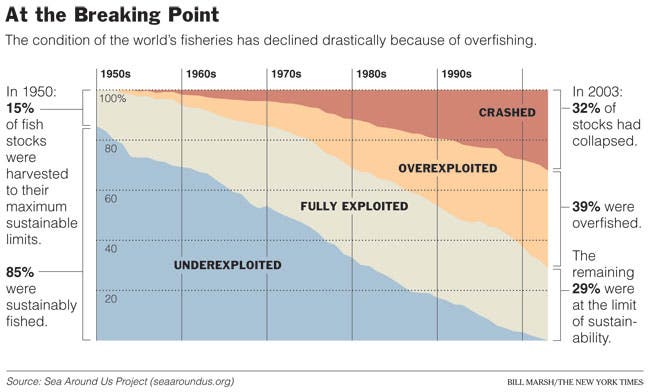Whenever you’re eating a fish or some other marine creature, think just for a moment that it may actually be worth more as a CO2 storing machine than a food.
First of all, let’s just make this clear: we’re unsustainably eating fish. If we continue current trends, we’ll soon be facing a massive fish crisis, as depicted in the image above. As you can see for yourself, there are virtually no more unexploited fish stocks, by now over a third of all fish stocks have already collapsed, and the situation is getting worse and worse every year. To add insult to injury, a new study has concluded that fish are actually worth more for the CO2 storing services they offer than on your plate.
By assigning a dollar value to carbon stored in ocean ecosystems, two recent scientific reports are attempting to make nations reconsider the true worth of their fishing activities.
The first one, conducted by the Global Ocean Commission, roughly estimates that fish and other aquatic life in the high seas absorb carbon dioxide which would otherwise cause damage between $74 billion to $222 billion every year. A more localized research showed that in the UK waters alone, the figure is $20 million every year.
But here’s the really awesome thing – the world’s fishing industry is worth $16 billion – way less value than the services which fish provide! Strictly from an economic point of view, it would be better to ban fishing altogether!
“Fish are actually really important in the global carbon cycle, and they’ve been rather neglected,” said Clive Trueman of the University of Southampton, lead author of the deep-sea fish study.
This study highlights once again the value of animals, and the damage we are causing overexploiting the planet’s resources – if we don’t start changing things, it will almost certainly come back to haunt us.
“I really think to use our oceans sensibly, we need to look at all the services that they provide and then find those that contribute to human welfare and well-being the most, and try to encourage that,” added Rashid Sumaila, professor and director of the fisheries economics research unit at the University of British Columbia, who co-authored the Global Ocean Commission report.
So how exactly do fish store CO2 in the oceans?
Phytoplankton, the ocean’s basic life form, from the bottom of the food chain, absorbs billions of tons of carbon dioxide each year. But because phytoplankton swims close to the surface, if it reaches the surface, it reemits most of the CO2 back into the atmosphere – if it isn’t eaten by any other marine animals, that is. Fish come and eat the phytoplankton, but then again, they don’t really swim that deep either. That’s when the deep sea dwelling fish come into action – they come and eat the fish which ate the phytoplankton, taking the CO2 back to the depths of the oceans and storing it there.
“These big, bottom-feeding, predatory fish are basically capturing the moving animals and storing that carbon by killing them and keeping them at the bottom,” Trueman said. “It’s only once the carbon fixed by phytoplankton actually gets below about 100 to 200 meters that it’s not free to get back to the atmosphere.”
It’s amazing to think that recently, we had no idea this was happening. The services they are providing us are huge, and yet we knew nothing about them – and even now, we only understand the general mechanism.
“We really don’t know very much about them, and yet they’re doing something pretty useful for us,” Trueman said.
Hopefully, we’ll be able to understand more and act accordingly, protecting world fisheries – before it’s too late.



